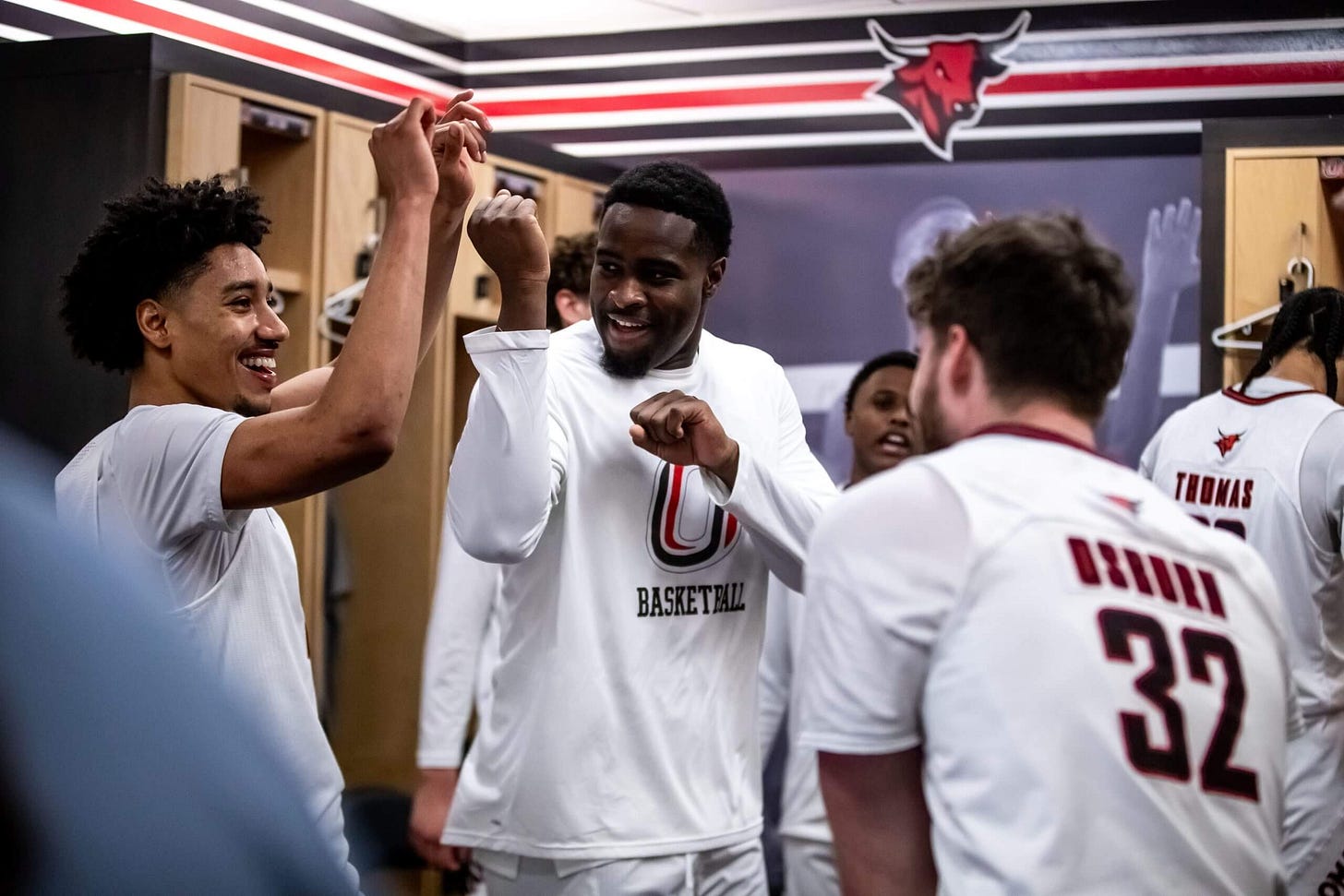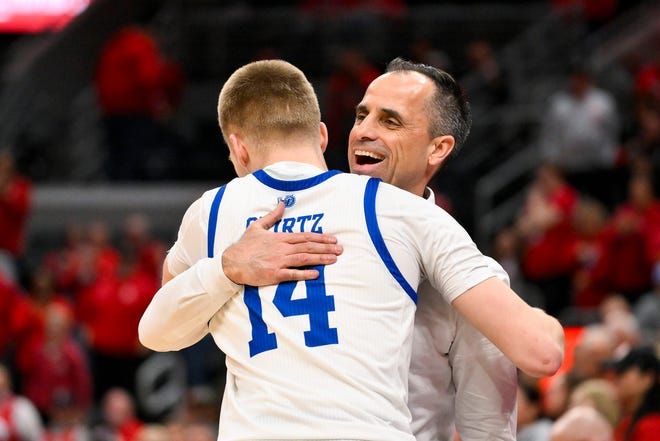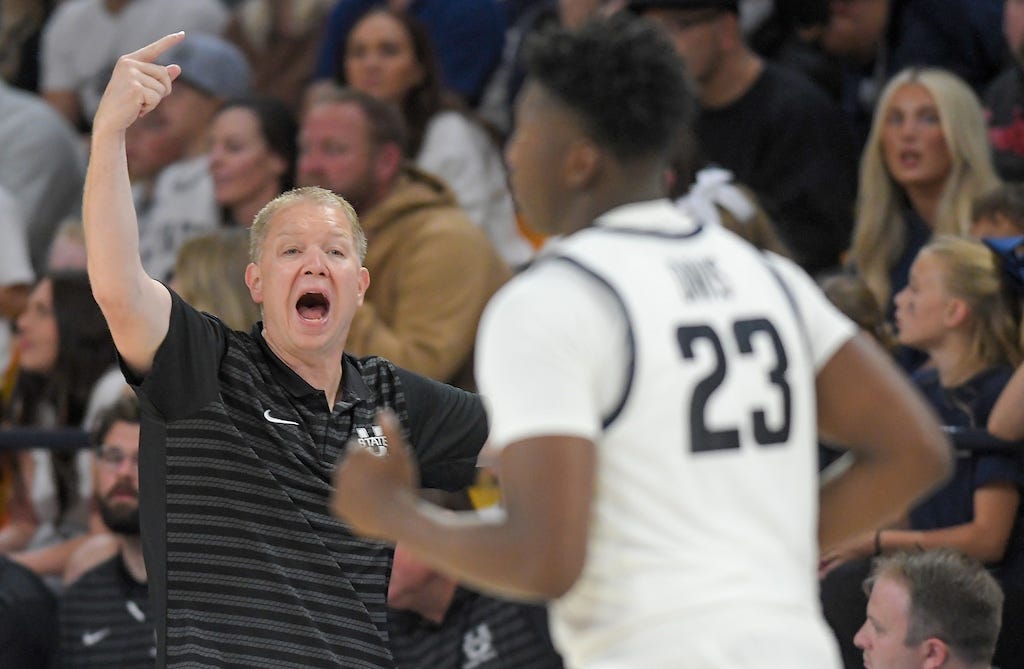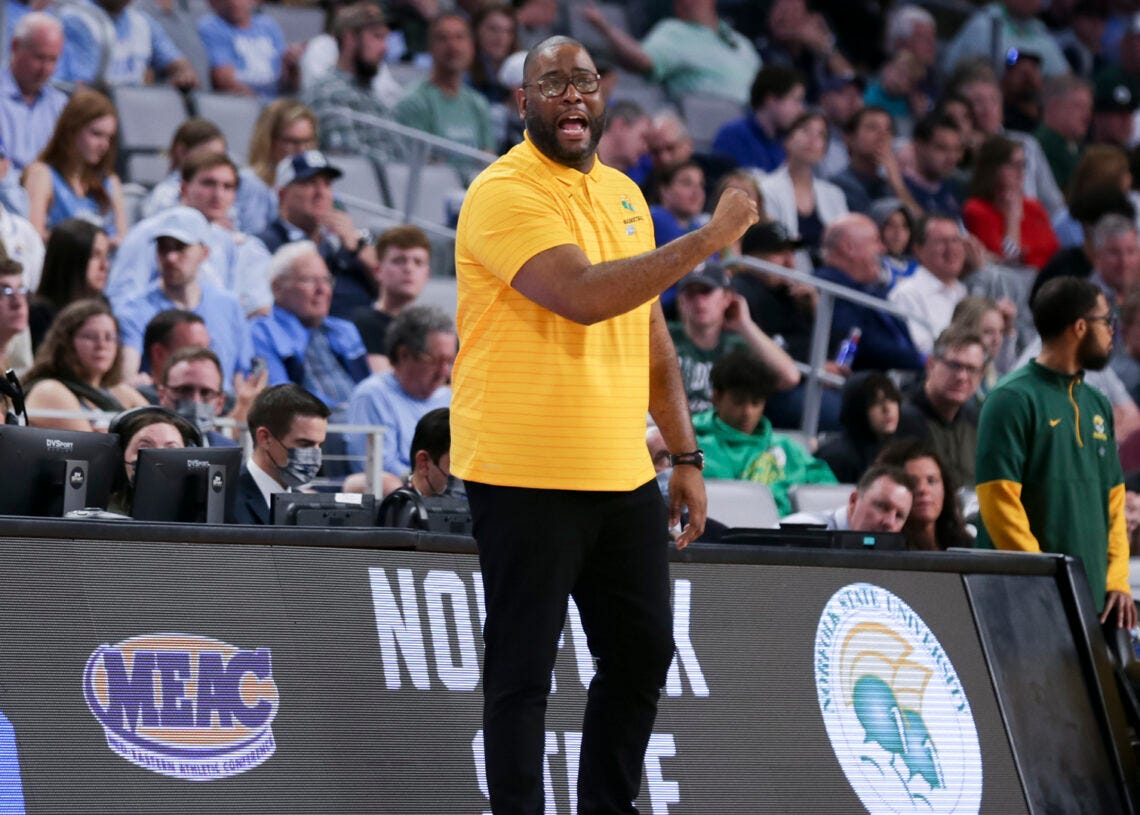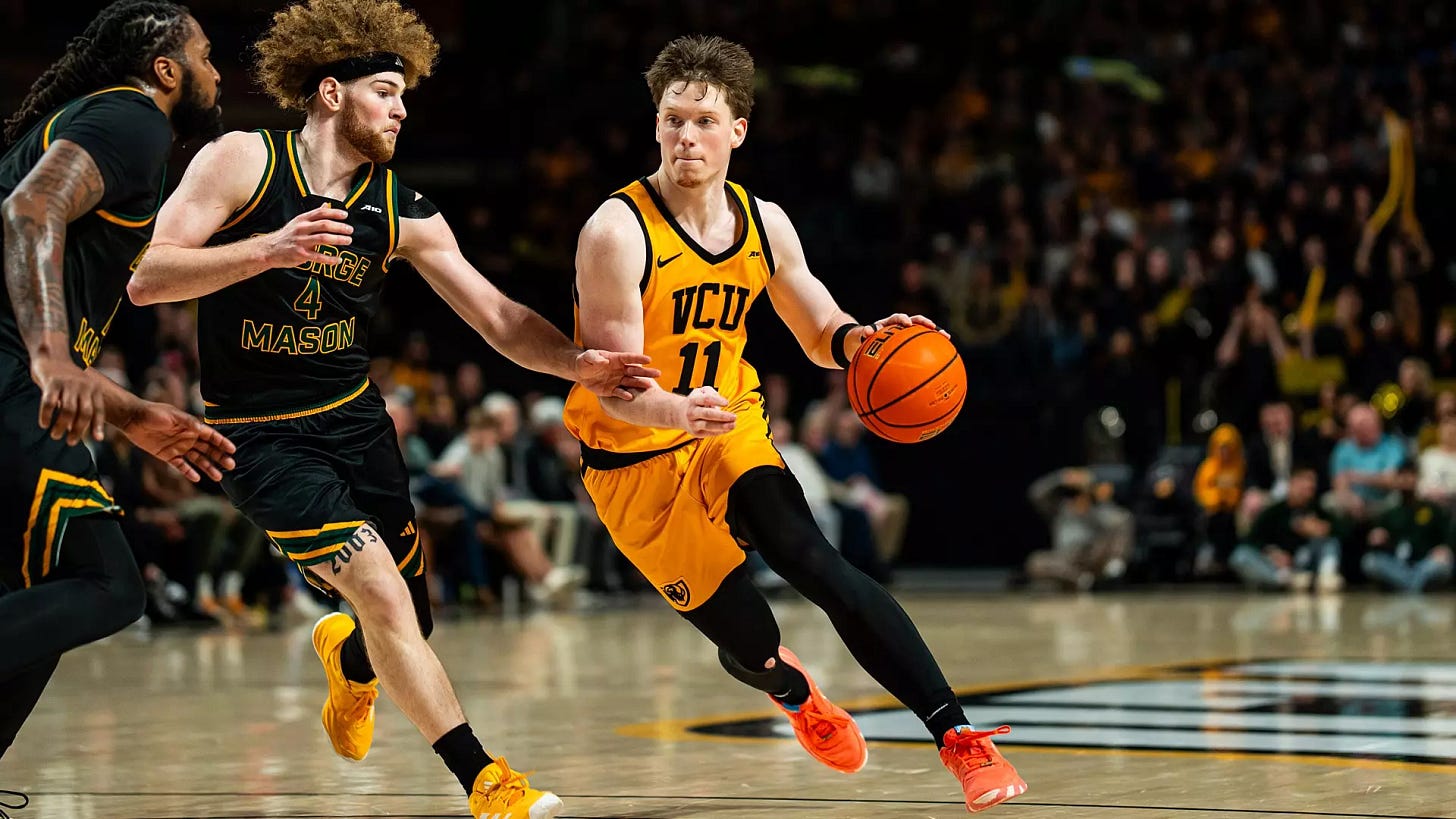The reminders of why we love March are everywhere
A look at some of the NCAA Tournament's best stories, whether or not they ultimately achieve Cinderella status
Every year, the NCAA Tournament bracket tells a story.
This year, many of the 68 teams that will compete this week on the biggest stage their sport has to offer embody the event’s best traits. There are the legendary coaches who provide some level of familiarity and comfort in an increasingly transient game. There are top seeds vying for a national title and completing their case as one of the best teams in college basketball’s modern era (I wrote about Auburn being historically good a couple of weeks ago, but the Tigers have since been lapped by Duke, Florida and Houston, all of which have higher efficiency margins on KenPom than all of the past 15 national champions outside of last year’s UConn squad).
More than that, though, there are the underdogs, even if they’re that in name only. We’re talking here about the participants that give March Madness the kind of charm that no other major sporting event in the United States can come close to matching. For even those who pay attention to the sport three weeks out of the year, it’s an annual opportunity to fall in love.
Over the next handful of days – or maybe longer, depending on how much magic Cinderella has in her slippers (I think it’s slippers? I haven’t seen the movie in about 30 years) – there will be schools many have only vaguely heard of that will momentarily become as well known as Duke or Kentucky. Players and coaches will rise from anonymity and become national stars. It happens damn near every year and this season, even with as dominant as the Nos. 1 and 2 seeds have been the past four months, it surely will again.
To offer a glimpse at who some of these teams and individuals might be, or just to serve up a rooting guide, I wanted to dive into what I think are some of the more compelling teams in this year’s tournament. Depending on what transpires later this week, some of these squads could get etched into March lore alongside the likes of Villanova in 1985, Loyola Marymount in 1990, George Mason in 2006 or UMBC in 2018. Even if they exit the tournament as quickly as they entered it, their path to getting there still makes for one hell of a story.
Who will be some of the teams, programs and universities who will come to define this March?
The Division II team ripping through Division I
For years, Ben McCollum’s name was constantly brought up around the start of the NCAA Tournament, not as a March Madness folk hero, but someone who could someday be one, a man who had built a Division II juggernaut, had some of the best coaches in the country calling him to pick his brain and seemed destined to one day be leading a successful Division I head coach.
The day so many anticipated has now arrived. After a decorated 15-year run at Northwest Missouri State, where he won four national titles, McCollum made the long-awaited jump to the Division I ranks at Drake last year and has since guided the Bulldogs to a 30-3 mark and a sweep of the Missouri Valley regular-season and tournament titles. They play at a glacial pace – their adjusted tempo on KenPom is the slowest of any Division I team and is lower than all but one of Tony Bennett’s 15 squads at Virginia – but are well-balanced and could present an interesting stylistic mismatch in the tournament.
Perhaps most interestingly, he’s done all of that with a familiar group of players. Three of Drake’s top four scorers, and four of its five starters, came over with McCollum from Northwest Missouri State, which fell in the Division II Sweet 16 last season. For several years now, mid- and low-major programs have increasingly turned to accomplished Division II coaches rather than high-major assistants, figuring that someone who can stack up wins at that level of the sport could likely do the same at the top tier of the sport. For the most part, that assumption has panned out, as men like Josh Schertz at Indiana State and Tobin Anderson at Fairleigh Dickinson proved. But to take not just a coveted Division II coach, but his roster’s most successful parts? And come out with these kinds of results? We hadn’t quite seen anything like this until now.
Drake will be a popular upset pick, as a No. 11 seed facing off against a Missouri team that’s lost four of its past five. Whether or not his team makes a run, McCollum is no longer someone whose name is only discussed among basketball lifers or in off-the-beaten-path profiles from The Athletic. He’s been connected to the open jobs at Indiana, Iowa, Minnesota, Virginia and Villanova, with the Hoosiers reportedly quite interested in him succeeding Mike Woodson. His time at Drake may end up being short, but to paraphrase the university’s namesake, he would have at least been there for a good time, not a long time.
The Division I newcomer shooting 100% in tournament appearances
Like several of the bylaws and legal jargon in its dense manual, the NCAA has a well-intentioned but faulty rule that prohibits teams from competing in the NCAA Tournament in the first four years of their Division I transition.
While the measure is meant to prevent schools from making impulsive jumps they’re not logistically equipped to handle, it has blocked teams that were clearly good enough to make the Big Dance from competing in it. We’ve seen it in recent years with schools like Merrimack and Bellarmine that won their conference titles, but were ineligible to claim their league’s automatic bid.
This year, UC San Diego has shown us that the wait is sometimes worth it – and that the end of the NCAA’s probationary period can come at just the right time.
The Tritons made the leap from Division II to the Big West Conference in advance of the 2020-21 season. After suffering through three consecutive losing seasons, they went 21-12 last season and made the CBI. This season, they’ve morphed into a machine, rolling to a 30-4 mark that has been capped off by a Division I-best 15-game win streak that got them into the NCAA Tournament in their first year of eligibility. Even if they would have lost to UC Irvine in the Big West title game, they would have had a strong case to be an at-large team, ranking ahead of the likes of Creighton, North Carolina and Arkansas in the NET rankings.
Beyond that, they’re a fun team. They hoist up (and make) a ton of 3-pointers, ranking eighth nationally in 3-point rate. They turn opponents over a bunch. Their star player, 6-foot-6 guard Aniwaniwa Tait-Jones, is a New Zealand native who won Big West player of the year honors.
This could just be the beginning for UC San Diego. The school’s clearly capable of competing at this level. It has the largest enrollment of any Big West university. It’s an academically prestigious school with a quirky campus (including a library that looks straight out of “Severance”) that’s a short walk from the ocean in one of America’s nicest cities. And, at least for now, it has an excellent young coach in Eric Olen who has been there in some capacity for 21 years.
The idea of a mid- or low-major becoming the next Gonzaga is a trope, if only because it’s such an unattainable bar. But the Tritons would appear to have much of what you need to at least not completely laugh it off as a possibility. Even if they do become something remotely close to the Zags, they, like so many of us, will always remember their first time.
The bracket’s lone loser
As an early 20-something writing about prep sports and Robert Morris basketball at the Pittsburgh Post-Gazette, I rarely got to travel somewhere that didn’t have a 412 or 724 area code. Each year, however, there was always one exception, when I got to make the 80-mile drive east to Loretto, Pa., to cover the Colonials’ game against the Saint Francis Red Flash.
Every time I’d go, I’d arrive at the school’s campus and leave with the same unshakeable thought – how the hell do you recruit Division I-caliber basketball players here?
It’s a small school (about 1,600 undergrads) in a somehow even smaller town (about 1,200 residents, as of the last census) in middle-of-nowhere Pennsylvania that was founded by Franciscan Friars of the Third Order Regular in the mid-1800s. The sheer size of Division I has long boggled my mind, with schools as different as Ohio State and small liberal arts colleges competing at the same level of the sport. There’s an ongoing discussion in the wake of the House settlement about schools exploring the jump down to Division II or Division III in the face of impending direct payments to athletes that not everywhere can afford. To me, at least based on my personal experiences, Saint Francis was always a place that I wondered how it made it work at the Division I level.
This year, however, the Red Flash are off to the NCAA Tournament for the first time since 1991 after going on the road to stun Northeast Conference regular-season champion Central Connecticut State in a 46-43 slugfest to claim the league’s automatic bid.
The team is led by a Saint Francis lifer, coach Rob Krimmel, who played at the school in the late 1990s and has been there ever since, first as an assistant and now the head coach. If you think my evaluation of the school and its surroundings sounded harsh or condescending, even the Red Flash’s own coach once thought that way.
"My first impression of the place: I didn't like it," Krimmel said to CBS Sports. "I thought college was [Penn State’s] Beaver Stadium, 100,000 people, big campus. I grew up going to football games, basketball games, and my first trip up there, I told my dad, 'I'm not going to a school like that.'"
The school has a proud basketball history, with Maurice Stokes and Norm Van Lier among its most decorated alums. This year, however, is just its second NCAA Tournament bid ever – and it makes the field as the lone squad with a losing record. Against Alabama State in Tuesday’s play-in game in Dayton, it can get its first ever win in the Big Dance.
The garbage can’s biggest nightmare
Omaha’s 2024-25 season got off to an inauspicious start, with a 4-9 record in mid-December. By that point, the Mavericks had gone almost two full weeks without a win. Before their Dec. 21 game against Cal Poly, Kyan Brown, the team’s associate head coach, was prepared to offer a pep talk to the players when he noticed a big trash can sitting in the corner of the locker room.
He couldn’t conjure up a win-one-for-the-Gipper type speech to rally a beaten-down group, but did what he believed to be the next-best thing in that moment – he kicked the trash can. The team responded enthusiastically to it, prompting Brown to issue a promise to the inanimate object before heading out to the court.
"If you're still in here after the game," he said, "I'm gonna whip your ass again."
Omaha won and though Brown had forgotten his pre-game message by the time the final horn sounded, his players hadn’t. They encouraged him to unleash on the receptacle again and he happily obliged. From there, a tradition was born, one that has captured the imagination of much of the college basketball world.
Since that fateful kick, the Mavericks have gone 18-3, winning the Summit League regular-season and conference championships to earn their first-ever NCAA Tournament berth. The trash-can ritual has continued at home and on the road, with coaches and players conjuring new, inventful ways to clobber them, usually by imitating wrestling moves and pretending the bin is Stone Cold Steve Austin or Rowdy Roddy Piper rather than a plastic cylinder.
The school has embraced it, too, turning it into one of the more inspired marketing promotions I’ve ever seen – fans could bring their own five-gallon or smaller garbage cans to the arena for Omaha’s Feb. 1 game against Denver and have them filled up with popcorn at the venue’s concession stands. The university saw a 1,400% increase in ticket sales from the previous five months and had a final crowd of 3,356, by far their largest crowd of the season to that point.
When they beat St. Thomas in the Summit League championship game on March 10, they celebrated the only way they could.
The odds of them vanquishing Rick Pitino and St. John’s in a two-versus-15 matchup are extraordinarily long, but if they manage to pull it off, they’ll know just where to find the brackets that so many people will have to rip up and toss out.
The program that won’t stop winning
Instability is usually a program killer, with even once wildly successful entities unable to withstand a series of short coaching tenures.
In that way, Utah State’s a bit of an outlier.
The Aggies are back in the NCAA Tournament, this time as a No. 10 seed with a first-round date with UCLA. It’s the fifth time in the past six seasons in which the tournament was held that Utah State made it, but more notably, it’s done so with four different coaches.
Craig Smith led the program for three seasons before leaving for Utah in 2021. Ryan Odom, who led UMBC to the historic one-over-16 upset of Virginia in 2018, replaced him and stuck around for two years before heading back east for VCU. Danny Sprinkle came over from Montana State, won a Mountain West regular-season title and bounced after just a year for Washington.
Serving as the third different Utah State head coach in as many seasons, Jerrod Calhoun has guided the Aggies to a 26-7 mark this season and briefly had them ranked in the top 25 of the Associated Press poll after a blistering 16-1 start. During the coaching transition, Utah State lost reigning Mountain West player of the year Great Osobor, who followed Sprinkle to Washington and earned what was reported to be a $2 million NIL deal, but Calhoun was able to retain what have become three of the team’s top five scorers while making some key adds from the transfer portal.
According to the university, it’s just the second school ever since the NCAA Tournament expanded to 64 teams in 1985 that has qualified for the event in three consecutive seasons and with three different coaches (Southern Illinois did it from 2003-05 with Bruce Weber, Matt Painter and Chris Lowery). Utah State did it by not restricting itself or its candidate pool in its search. Instead of clinging to arbitrary ideas like a coach’s potential fit, especially geographically, they simply hired proven winners. Smith was a son of the upper midwest who had spent much of his life and career there. Odom was born and bred in ACC country, the son of former Wake Forest coach Dave Odom who had never coached north of Baltimore, south of Tampa or west of Asheville, N.C. Calhoun is an Ohio native who had spent his entire life in the midwest or Appalachia before accepting the Utah State job last spring.
“I think when I came out here I just felt an instant connection to the place,” Calhoun said to USA Today. “I wanted to go to a place that kind of fit me and my family, and a place where they really care about basketball.”
Depending on how the dominos in the coaching carousel fall, Utah State could find itself in a familiar but not-so-desirable position. West Virginia’s Darian DeVries has been linked to both the Indiana and Iowa vacancies and should he leave the Mountaineers after a year, Calhoun, a former Bob Huggins player who coached under him for five years in Morgantown, would be a no-brainer replacement.
If it comes to that, recent history has shown us things will work out just fine.
The first-timers’ club
There are four programs this season making their first-ever NCAA Tournament appearances. Two of them we’ve already gone over – UC San Diego and Omaha – but also in that jubilant club are SIU Edwardsville and High Point, which have been Division I members since 2008 and 1999, respectively.
With that, there are now 34 current Division I programs – just shy of 10% of the overall membership – that have never made the NCAA Tournament. Hopefully, we see some more of those droughts end 12 months from now.
The coach who found his way back
In 2018, and far away from the brightest lights of the sport, one of the most baffling decisions by a college athletics administrator was made (and whew buddy, that’s a high bar).
After leading his UT Arlington team to a 21-9 record, which capped off a three-year run in which the Mavericks went 72-33, Scott Cross was fired by the university where he once played and was an academic all-American, despite being the program’s all-time wins leader and the only coach who had ever guided it to the NCAA Tournament. At the time, UT Arlington athletic director Jim Baker bristled at the notion that firing a coach coming off three consecutive seasons with at least 20 wins was unreasonable.
“Some people say, ‘Well, you’re UTA,’ you should be happy,'” Baker said to the Dallas Morning News. “That’s not our president. That’s not me. We want to be the best at what we do. Your aspirations have to be that you can get to the NCAAs every year. That’s what we want.”
After a one-year stop as an assistant coach at TCU, Cross was hired by Troy as its head coach in 2019, tasked with overseeing a program that had finished with a winning record just once in the previous nine seasons.
In each of the past four seasons under Cross, the Trojans have won at least 20 games, a mark they had previously reached only four times in their 28-year history in Division I. This year, Troy is 23-10 and making just its third-ever appearance in the NCAA Tournament, where it will face off against No. 3 seed Kentucky.
As for the UT Arlington program that thought it was too good for him? Since Cross’ ouster, the Mavericks are 99-118, have won more than 17 games just once in seven seasons and went 13-18 in 2024-25, including a 6-10 mark in WAC play. Baker, the athletic director who fired him, retired in Sept. 2022.
The coach who should be a barrier-breaker
On a bracket with familiar names like Kansas, Duke and Kentucky, there’s another, much less glamorous school that has become a fixture of the event in recent years – Norfolk State.
The Spartans are in the field of 68 for the third time in the past five seasons. In the two years during that stretch that they didn’t make it, they went a combined 46-22. Over the past five seasons, they’re 111-47.
It’s the type of run that would naturally lead someone to assume that the program went through a change in leadership at some point, with a consistent winner doing what many consistent winners do at the low- and mid-major level and eventually leave for a bigger, more lucrative job. However, Norfolk State coach Robert Jones is in his 12th season at the school.
The reason for that doesn’t require much strenuous thought or an exhaustive investigation. Norfolk State is an HBCU in a conference, the Mid-Eastern Athletic Conference, filled with similar institutions. The upward mobility that’s effectively a guarantee for any winning coach at a mid- or low-major is a rarity for those sitting atop HBCU programs.
Since 2000, there have been only six instances of an HBCU coach leaving directly for a job at a predominantly white institution. The majority of those cases were made possible by special circumstances. Two of the coaches who made the leap were white. One of them, Mike Davis, had previously been a head coach at Indiana and UAB, the former of which he led to the national title game in 2002. Another, Sean Woods, was a revered former Kentucky player whose name still carried weight in the state, allowing him to go from Mississippi Valley State to Morehead State.
The situation is so bleak for coaches at HBCUs that former Old Dominion coach Jeff Capel II, an HBCU graduate who coached at HBCUs for years, once advised his son, current Pitt coach Jeff Capel III, not to take a job at an HBCU because it’s hard, if not impossible, to move up to a bigger program.
“You do get pigeonholed,” North Carolina Central coach LeVelle Moton told me in 2019. “It’s almost like Major League Baseball and then the Negro Leagues. It’s Satchel Paige and Josh Gibson and Cool Papa Bell and Jackie Robinson. They’re over here and everyone else is pretty much over there. They’re not invited to the party.”
A market inefficiency – and, frankly, that seems like the most generous way to put it – has worked out in Norfolk State’s favor. The Spartans have managed to hold on to a coach with a resume that would have earned him a bigger payday years ago if he were coaching at a different college in a different league and, maybe just maybe, had different colored skin. It’s a situation that has greatly benefited the basketball program, its players and the university as a whole.
Still, a positive result for a single school doesn’t wash away the sins of a rotten, fundamentally broken system.
The player for whom basketball is more than a game
It’s been more than a decade since VCU could reasonably have been considered a Cinderella, with this season marking the Rams’ 12th NCAA Tournament appearance in the past 14 years in which the event was held.
Their best player this season, though, embodies that underdog spirit that used to define the program.
Senior guard Max Shulga has been the catalyst for VCU’s stellar 2024-25 season, earning Atlantic 10 player of the year honors while carrying his team to a 28-6 record and conference regular-season and tournament championships.
As Shulga has excelled on the court, he has had worries that extend far beyond it.
Shulga’s a native of Ukraine, where his family still resides in Kyiv as the country continues fighting off an invasion from Russia more than three years after troops made their first push into the sovereign nation. He has dealt with abuse at times over the course of his college career, like in Feb. 2023 when Shulga, then at Utah State, had chants of “Russia” directed at him by a small group of fans when he was at the free-throw line in a game at Colorado State.
The uncertainty that has gripped his life has only magnified in recent weeks, between Donald Trump’s contentious White House meeting with Volodymyr Zelenskyy and the United States pausing military and intelligence support to Ukraine. Through all of that, he has found a sense of community at VCU, where fans have chanted “Slava Ukraini” and waved blue-and-yellow Ukrainian flags for the school’s senior night ceremony earlier this month.
“When I’m on the court, playing in the game, everything kind of just goes away,” Shulga said to The Guardian. “And I’m just in the moment focused on what’s at hand and what I’m doing in that particular game. Basketball helped me to just stay focused. Anything that has been going on, basketball will be my getaway, my outlet.”
For all that may ail and divide us, the NCAA Tournament, inconsequential as it may be in the grand scheme of things, can help bring us together for three weeks.
And isn’t that what this beautiful time of year is all about?
(Photos: Omaha Athletics, Imagn Images, Saint Francis Athletics, Herald Journal, Norfolk State Athletics, VCU Athletics)




